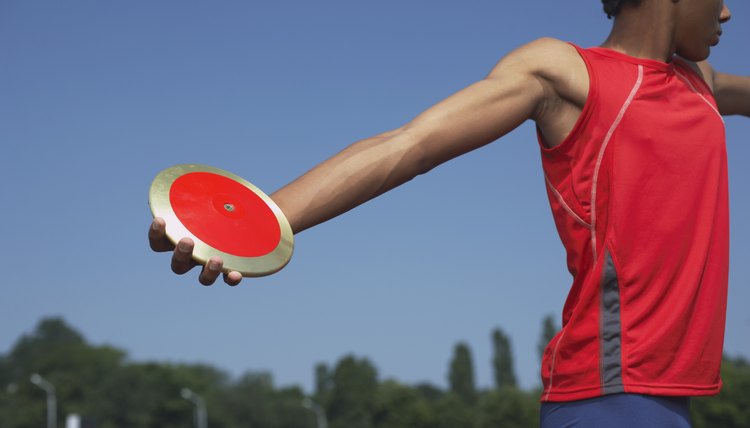Discus Thrower Injuries

Correctly and safely throwing a discus requires knowledge of a special hurling technique that involves spinning the body several times and releasing a plate-shaped object from the hand into the air. Discus throwing engages all body muscles, from feet to core to shoulder muscles. Initially, preparing to throw a discus requires using lower-body muscles to gain momentum. Hip rotator muscles assist in forcefully rotating the body, along with the quadriceps, hamstrings, gastrocnemius and tibialis anterior. Pectorals, upper-arm and shoulder muscles finish the motion of the discus throw, with hand and wrist ligaments absorbing the energy from these muscles conducive to releasing the discus as vigorously as possible.
Glenoid Labrum Injury
The glenoid labrum (GL) is a circular piece of tissue fiber attached to the edge of the glenoid, a small depression in the shoulder blade that allows for placement of the humerus. Frequently, glenohumeral ligaments are strained by repetitive overhead throwing, as is practiced in discus throwing. GL strains are superior or inferior, depending on whether the injury happened at the top or lower part of the glenoid socket. Symptoms of a GL tear include unspecific shoulder pain, weakness in the shoulder area and general shoulder instability. Applying ice packs, resting and engaging in strengthening exercises are recommended for a full recovery of a glenoid labrum injury.
Rotator Cuff Injury
The rotator cuff is a group of four muscles constituting the area around the shoulder blade. It is responsible for stabilizing shoulder joints and facilitating actions involving rotation. Rotator cuff muscles are vulnerable to a variety of injuries, such as tears and tendinitis. Regular discus throwers may suffer from overuse of these ligaments and muscles, resulting in pain when employing the shoulder to release the discus. Tendinitis that is not treated properly may eventually present serious ruptures requiring extensive rest and rehabilitation. However, when given immediate treatment, most rotator cuff injuries heal on their own.
Labral Tear of the Hip
The labral is a round piece of cartilage lining the hip socket where the thigh bone is located. It is meant for support and cushioning of the joint. Tears frequently occur in athletes who place repetitive strain on the hip joint or perform twisting motions while using this joint. Discus throwers may experience pain in the groin or hip, stiffness and clicking noises when moving the hip. Labral tear symptoms may not appear immediately after the injury but may worsen progressively over a period of time. The only method to accurately diagnose a labral tear is implementing an MRI scan of the hip joint. Treatment usually requires minor surgery.
Ankle Sprains
Because the discus thrower spins several times before throwing the discus, ankle sprains are commonly experienced due to poor technique and placing the ankle in an abnormal position. Ligaments that make up the ankle joint are torn or stretched in an ankle sprain. Sometimes a popping or snapping sound is heard, quickly followed by swelling and pain. Three grades of ankle sprain exist, and all can be suffered by a discus thrower at any time. Treatment of minor or moderate ankle sprains consists of rest, ice, compression and elevation, commonly referred to as RICE. Wrapping the ankle with a sports bandage may alleviate pain, as well. More serious ankle sprains may require surgery and rehabilitation exercises, depending on the location and extent of the tear.
References
- SportsInjuryClinic.net: Glenoid Labrum Injury
- TeachPE: Throwing Injuries
- Indiana University: Biomechanics of Human Performance
- ACSM's Resources for the Personal Trainer; American College of Sports Medicine
Writer Bio
Rick Rockwell is a self-employed personal trainer and experienced freelance writer. His articles have been published throughout the Internet. He has more than eight years of experience as a certified personal trainer, group fitness instructor and lifestyle coach. His company, Rockwell Fitness, is dedicated to educating and empowering others to live healthy lifestyles.
